Reptiles and Amphibians
Media

Species Types
Scientific Name
Coluber constrictor flaviventris (eastern yellow-bellied racer) and Coluber constrictor priapus (southern black racer)
Description
The eastern yellow-bellied racer is uniformly tan, brown, olive, blue, gray, or nearly black on top, with a yellow, cream, or light blue-gray belly. It occurs nearly statewide. The southern black racer subspecies also lives in the southeastern half of the state.
Media

Species Types
Scientific Name
Necturus maculosus maculosus
Description
Mudpuppies are aquatic salamanders that have plumelike external gills throughout their entire lives. They’re found in the southern half and along the eastern edge of Missouri.
Media
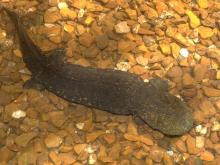
Species Types
Scientific Name
Cryptobranchus alleganiensis alleganiensis
Description
The eastern hellbender is a large, entirely aquatic salamander with a wide, flat head, small, lidless eyes, and soft folds of skin on the sides. In Missouri, it occurs in the northern Ozark highlands in spring-fed rivers that drain north into the Missouri and Meramec river drainages.
Media
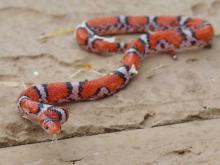
Species Types
Scientific Name
Cemophora coccinea copei
Description
One of Missouri's most brilliantly colored snakes is also extremely rare to find. The northern scarletsnake is similar in pattern and color to the more common red milksnake but has a red or orange snout and a spotless, white belly.
Media

Species Types
Scientific Name
Lampropeltis triangulum
Description
The harmless eastern milksnake is white, yellow, or light tan, with red or orange blotches bordered with black. The belly is white and strongly checked with black. This species often is misidentified as the venomous coralsnake, which is not found in Missouri.
Media
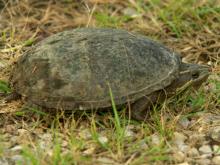
Species Types
Scientific Name
Sternotherus odoratus
Description
The eastern musk turtle is one of the world’s smallest turtles. It has a dark, domed upper shell and reduced lower shell. It occurs along our Mississippi River counties and in the southern two-thirds of the state.
Media

Species Types
Scientific Name
Apalone spinifera spinifera
Description
The eastern spiny softshell is a medium to large softshell turtle with small bumps or spines on the front edge of the upper shell. There are dark spots on the fore- and hind limbs.
Media
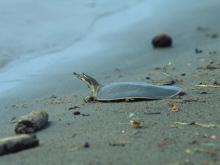
Species Types
Scientific Name
Apalone mutica mutica
Description
The midland smooth softshell is a rather plain-looking softshell turtle, with a smooth, rather featureless olive-gray or brown shell, and a light stripe bordered by black extending backward from each eye.
Media

Species Types
Scientific Name
Lithobates palustris (formerly Rana palustris)
Description
The pickerel frog is medium-sized, with square or rectangular spots in two parallel rows down the back. There is a distinct ridge of skin along each side of the back. It is absent from the northwestern third of Missouri.
Media
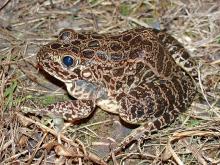
Species Types
Scientific Name
Lithobates areolatus circulosus
Description
A very secretive species, the northern crawfish frog spends most of its time hidden burrows, typically those made by crayfish. It is restricted to native prairie or former prairie areas and is a species of conservation concern in Missouri.
See Also
About Reptiles and Amphibians in Missouri
Missouri’s herptiles comprise 43 amphibians and 75 reptiles. Amphibians, including salamanders, toads, and frogs, are vertebrate animals that spend at least part of their life cycle in water. They usually have moist skin, lack scales or claws, and are ectothermal (cold-blooded), so they do not produce their own body heat the way birds and mammals do. Reptiles, including turtles, lizards, and snakes, are also vertebrates, and most are ectothermal, but unlike amphibians, reptiles have dry skin with scales, the ones with legs have claws, and they do not have to live part of their lives in water.





















